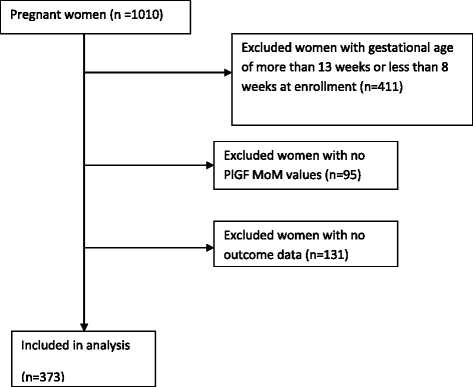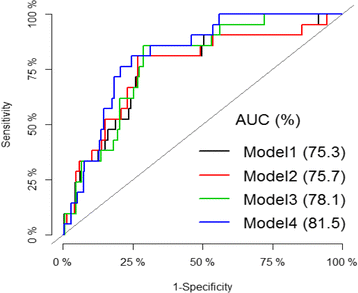Improved prediction of gestational hypertension by inclusion of placental growth factor and pregnancy associated plasma protein-a in a sample of Ghanaian women
- PMID: 29587776
- PMCID: PMC5870183
- DOI: 10.1186/s12978-018-0492-9
Improved prediction of gestational hypertension by inclusion of placental growth factor and pregnancy associated plasma protein-a in a sample of Ghanaian women
Abstract
Background: We assessed whether adding the biomarkers Pregnancy Associated Plasma Protein-A (PAPP-A) and Placental Growth Factor (PlGF) to maternal clinical characteristics improved the prediction of a previously developed model for gestational hypertension in a cohort of Ghanaian pregnant women.
Methods: This study was nested in a prospective cohort of 1010 pregnant women attending antenatal clinics in two public hospitals in Accra, Ghana. Pregnant women who were normotensive, at a gestational age at recruitment of between 8 and 13 weeks and provided a blood sample for biomarker analysis were eligible for inclusion. From serum, biomarkers PAPP-A and PlGF concentrations were measured by the AutoDELFIA immunoassay method and multiple of the median (MoM) values corrected for gestational age (PAPP-A and PlGF) and maternal weight (PAPP-A) were calculated. To obtain prediction models, these biomarkers were included with clinical predictors maternal weight, height, diastolic blood pressure, a previous history of gestational hypertension, history of hypertension in parents and parity in a logistic regression to obtain prediction models. The Area Under the Receiver Operating Characteristic Curve (AUC) was used to assess the predictive ability of the models.
Results: Three hundred and seventy three women participated in this study. The area under the curve (AUC) of the model with only maternal clinical characteristics was 0.75 (0.64-0.86) and 0.89(0.73-1.00) for multiparous and primigravid women respectively. The AUCs after inclusion of both PAPP-A and PlGF were 0.82 (0.74-0.89) and 0.95 (0.87-1.00) for multiparous and primigravid women respectively.
Conclusion: Adding the biomarkers PAPP-A and PlGF to maternal characteristics to a prediction model for gestational hypertension in a cohort of Ghanaian pregnant women improved predictive ability. Further research using larger sample sizes in similar settings to validate these findings is recommended.
Keywords: Biomarkers; Gestational hypertension; Hypertensive disorders of pregnancy; Prediction model.
Conflict of interest statement
Ethics approval and consent to participate
Ethics approval for this study was granted by the Ghana Health Service Ethics Review Committee (Committee Reference Number: GHS-ERC 07/09/11). All participating women gave written informed consent before they were enrolled in the study.
Consent for publication
Not applicable.
Competing interests
The authors declare that they have no competing interests.
Publisher’s Note
Springer Nature remains neutral with regard to jurisdictional claims in published maps and institutional affiliations.
Figures


References
-
- Hutcheon JA, Lisonkova S, Joseph KS. Epidemiology of pre-eclampsia and the other hypertensive disorders of pregnancy. Best Pract Res Clin Obstetr Gynaecol. 2011;25(4):391–403. - PubMed
-
- Peters RM, Flack JM. Hypertensive disorders of pregnancy. J Obstet Gynecol Neonatal Nurs. 2004;33(2):209–220. - PubMed
-
- Nijdam ME, Janssen KJ, Moons KG, Grobbee DE, van der Post JA, Bots ML, Franx A. Prediction model for hypertension in pregnancy in nulliparous women using information obtained at the first antenatal visit. J Hypertens. 2010;28(1):119–26. - PubMed
Publication types
MeSH terms
Substances
Grants and funding
LinkOut - more resources
Full Text Sources
Other Literature Sources
Medical
Miscellaneous

